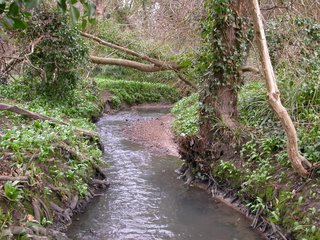
On 27 March I went to St Leonards-on-Sea to look at two open areas on either side of a suburban road. They were good quality neutral grassland (MG5 in the National Vegetation Classification) with a wide range of different plants including some celandines in flower far from the nearest hedge.
I also walked down into the valley of the Hollington Stream, now with a good flow following recent rain (see photo above). A very attractive spot for the heart of a suburb, with the bright green of the ramson leaves (Allium ursinum) making it feel like spring at last.
Today I was at a launch of the Weald Ancient Woodland Survey in Crowborough. This really just added all the smaller - less than 2 hectare - woodland blocks in Wealden District to the existing provisional inventory done some years ago. While there I reflected that we call the habitat 'woodland' rather than 'treeland' a reference perhaps to the fact that woods were seen as an important economic resource (of wood), rather than a place one went to enjoy the trees.











